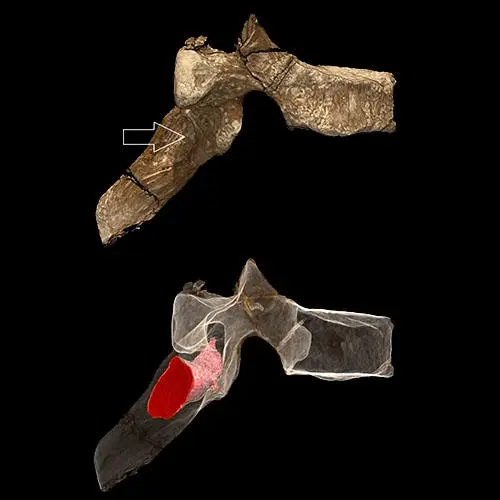International research team discovers most ancient evidence for cancer and bony tumours in human ancestors to date
An international team of researchers today announced in two papers, published in the South African Journal of Science, the discovery of the most ancient evidence for cancer and bony tumours yet described in the human fossil record, from two cave sites in South Africa.
The discovery of a foot bone dated to approximately 1.7 million years ago from the site of Swartkrans with definitive evidence of malignant cancer, pushes the oldest date for this disease back from recent times into deep prehistory. Though the exact species to which the foot bone belongs is unknown, it is clearly that of a hominin, or bipedal human relative. In an accompanying paper appearing in the same journal, a collaborating team of scientists identify the oldest tumour ever found in the human fossil record, a benign neoplasm found in the vertebrae of the well-known Australopithecus sediba child, Karabo from the site of Malapa, and dated to almost two million years in age. The oldest previously demonstrated possible hominin tumour was found in the rib of a Neanderthal and dated to around 120,000 years old.
Dr Patrick Randolph-Quinney, Senior Lecturer in Biological and Forensic Anthropology at the University of Central Lancashire (UCLan), is the lead author of the tumour paper and co-author of the cancer paper. He suggested: “The presence of a benign tumour in Australopithecus sediba is fascinating not only because it is found in the back, an extremely rare place for such a disease to manifest in modern humans, but also because it is found in a child. This in fact is the first evidence of such a disease in a young individual in the whole of the fossil human record.”
Edward Odes, a University of the Witwatersrand (Wits) doctoral candidate and lead author of the cancer paper, and co-author on the tumour paper, noted: “Modern medicine tends to assume that cancers and tumours in humans are diseases caused by modern lifestyles and environments, our studies show the origins of these diseases occurred in our ancient relatives millions of years before modern industrial societies existed”.
The cancer in a foot bone, a metatarsal, was identified as an osteosarcoma, an aggressive form of cancer which usually effects younger individuals in modern humans, and if untreated typically results in early death.
“Due to its preservation we don’t know whether the single cancerous foot bone belongs to an adult or child, nor whether the cancer caused the death of this individual” said Dr Bernhard Zipfel, a Wits scientist and an expert on the foot and locomotion of early human relatives, “but we can tell this would have affected the individuals’ ability to walk or run,” he added, “In short it would have been painful”.
Professor Lee Berger, an author on both papers and leader of the Malapa project where the fossil vertebra was found, added: “Not only has there been an assumption that these sorts of cancers and tumours are diseases of modernity, which these fossils clearly demonstrate they are not, but that we as modern humans exhibit them as a consequence of living longer, yet this rare tumour is found in a young child” he further notes “that the history of these types of tumours and cancers is clearly more complex than previously thought.”
"The presence of a benign tumour in Australopithecus sediba is fascinating not only because it is found in the back, an extremely rare place for such a disease to manifest in modern humans"
Both incidences of disease were diagnosed using state of the art imaging technologies including those at the European Synchrotron Research Facility in Grenoble, France, medical CT at the Charlotte Maxeke Hospital in Johannesburg, and the micro-CT facility at the Nuclear Energy Corporation of South Africa at Pelindaba.
The research on both papers was coordinated by UCLan’s Dr Randolph-Quinney (formerly of Wits), and comprises researchers from the University of the Witwatersrand’s Evolutionary Studies Institute, the South African Centre for Excellence in PalaeoSciences, and the School of Anatomical Sciences, New York University, Chaffey College, Duke University, and Lincoln Memorial University in the United States, the South African Nuclear Energy Corporation (NECSA), and the European Synchrotron Radiation Facility (ESRF).
Watch an interview with Dr Randolph-Quinney discussing the research.
* of Australopithecus sediba from the site of Malapa, South Africa, which shows the earliest evidence of a tumour (osteoid osteoma or osteoblastoma) in the human lineage. The fossil was scanned at the European Synchrotron Research Facility (ESRF), which allowed the internal morphology the bone and the effects of the tumour to be visualised. The top image shows a surface rendered image of the fossil based on the synchrotron scan, and the bottom image shows the boundary of the void left by the tumour as a partially transparent model. Image credit: Paul Tafforeau (ESRF).


